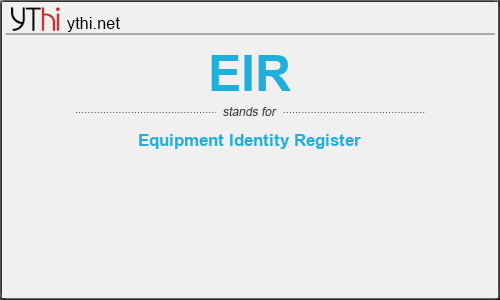What does EIR mean? What is the full form of EIR?
The full form of EIR is Equipment Identity Register
A handset theft problem exists in GSM networks in many countries. A person obtains a legitimate subscription to a network, and then obtains a legitimate IMSI, MSISDN, and SIM card. The person initially buys an inexpensive handset and then steals a better handset from another subscriber. After the handset is stolen, the thief replaces the SIM card with a legitimate SIM card. Because the SIM card and subscriber information contained on the SIM card (IMSI, MSISDN) are legitimate, the phone will operate and the network operator cannot determine that the subscriber is using a stolen handset. In addition to individual handset theft, organized groups stealing entire shipments of mobile handsets from warehouses and sell these handsets on the Black Market.
The Equipment Identity Register (EIR) is a network entity used in GSM networks that stores lists of International Mobile Equipment Identity (IMEI) numbers, which correspond to physical handsets (not subscribers). The IMEI is used to identify the actual handset and is not dependent upon the International Mobile Subscriber Identity (IMSI), Mobile Station ISDN Number (MSISDN), or the Subscriber Identity Module (SIM). The IMSI, MSISDN, and SIM are all subscriber-specific and move with the subscriber when purchasing a new handset. The IMEI is handset-specific.
The EIR feature can be used to reduce the number of GSM handset thefts by providing a mechanism that allows network operators to prevent stolen or disallowed handsets from accessing the network. This control is accomplished by comparing the IMEI that is provided during handset registration to the following set of lists provided by the network operator:
-
Black – Mobile Stations (MS) on the Blacklist are denied access to the network
-
Gray – MSs on the Graylist are allowed on the network, but may be tracked
-
White – MSs on the Whitelist are allowed access to the network
The Oracle Communications User Data Repository (UDR) stores the Whitelist, Graylist, and Blacklist of IMEI numbers. When a subscriber roams to a new MSC or VLR location, the handset attempts registration with the MSC or VLR. Before the MSC registers the subscriber with the VLR, it may send a query to DSR for EIR status of the handset. DSR returns a response indicating whether the IMEI is allowed, disallowed, or not valid. If the IMEI is allowed, the MSC completes registration; otherwise, registration is rejected.
EIR may also contain associations between individual IMEIs and IMSIs. This can provide a further level of screening by directly associating a particular IMEI with a particular IMSI. This association is used in the following way:
- If an IMEI is found on a Blacklist, an additional check of the IMSI could then be made.
- If the IMSI from the handset matches the IMSI provisioned with the IMEI, this would override the Blacklist condition and allow registration to continue. This could be used to protect against mistaken Blacklist entries in the database, or to prevent unauthorized “handset sharing.”
The IMSI Range Logic Support feature includes an IMSI range check logic before an IMEI lookup in the database. This feature helps to allow a specific set of subscribers on basis of IMSI.
EIR
means
Equipment Identity Register![]()
Translate Equipment Identity Register to other language.


Leave a Reply
You must be logged in to post a comment.